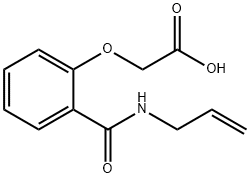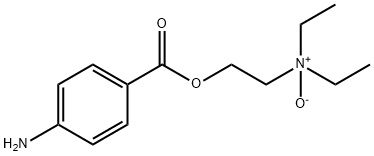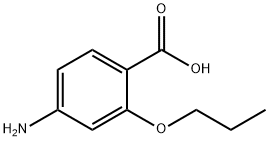Procaine
- CAS NO.:59-46-1
- Empirical Formula: C13H20N2O2
- Molecular Weight: 236.31
- MDL number: MFCD00007893
- EINECS: 200-426-9
- SAFETY DATA SHEET (SDS)
- Update Date: 2024-12-18 19:01:08

What is Procaine?
Description
Procaine is a local anesthetic with a para-amino function. Sensitization mainly concerns medical, dental and veterinary professions.
Chemical properties
The hydrochloride salt of 2-(diethylamino) ethyl p-aminobenzoate (C13H21ClN2O2 or N2C6H4COOCH2CH2NH(C2H5)2HCl) is generally referred to as procaine. Although the PABA ester is insoluble in water, the hydrochloride salt is very soluble in water.
The Uses of Procaine
Procaine is a sodium channel blocker and inhibitor of a variety of processes.
The Uses of Procaine
Procaine (Novocain) is mainly used in dental or medical procedures requiring infiltration anesthesia, peripheral block, or spinal block.
What are the applications of Application
Procaine is a sodium channel blocker and inhibitor of a variety of processes
Definition
ChEBI:Procaine is a benzoate ester, formally the result of esterification of 4-aminobenzoic acid with 2-diethylaminoethanol but formed experimentally by reaction of ethyl 4-aminobenzoate with 2-diethylaminoethanol. It has a role as a local anaesthetic, a central nervous system depressant, a peripheral nervous system drug and a drug allergen. It is a benzoate ester, a substituted aniline and a tertiary amino compound. It is functionally related to a 2-diethylaminoethanol and a 4-aminobenzoic acid. It is a conjugate base of a procaine(1+).
Background
A local anesthetic of the ester type that has a slow onset and a short duration of action. It is mainly used for infiltration anesthesia, peripheral nerve block, and spinal block. (From Martindale, The Extra Pharmacopoeia, 30th ed, p1016). Procaine has also been investigated as an oral entry inhibitor in treatment-experienced HIV patients .
Indications
Used as a local anesthetic primarily in oral surgery
brand name
Novocain (Hospira).
Biological Functions
Procaine hydrochloride (Novocain) is readily hydrolyzed by plasma cholinesterase, although hepatic metabolism also occurs. It is not effective topically but is employed for infiltration, nerve block, and spinal anesthesia. It has a relatively slow onset and short (1 hour) duration of action. All concentrations can be combined with epinephrine. It is available in dental cartridges with phenylephrine as the vasoconstrictor.
General Description
Procaine was synthesized in 1904 to address the chemical instabilityof cocaine and the local irritation it produced. The pKa of procaine is 8.9; it has low lipid solubility and the estergroup is unstable in basic solutions. Procaine is available inconcentrations ranging from 0.25% to 10% with pHs adjustedto 5.5 to 6.0 for chemical stability. Procaine is also includedin some formulations of penicillin G to decrease the pain ofintramuscular injection.
Contact allergens
Procaine is a local anesthetic with para-amino function. Sensitization mainly concerns the medical, dental, and veterinary professions.
Mechanism of action
The fundamental mechanism of analgesia underlying all local anesthetics is the blockade of neurotransmission via inhibition of sodium channels along nerve fibers. Procaine acts mainly by inhibiting sodium influx through voltage gated sodium channels in the neuronal cell membrane of peripheral nerves. When the influx of sodium is interrupted, an action potential cannot arise and signal conduction is thus inhibited.
Pharmacokinetics
Procaine is an anesthetic agent indicated for production of local or regional anesthesia, particularly for oral surgery. Procaine (like cocaine) has the advantage of constricting blood vessels which reduces bleeding, unlike other local anesthetics like lidocaine. Procaine is an ester anesthetic. It is metabolized in the plasma by the enzyme pseudocholinesterase through hydrolysis into para-aminobenzoic acid (PABA), which is then excreted by the kidneys into the urine.
Clinical Use
Procaine is very quickly metabolizedin the plasma by cholinesterases and in the liver via ester hydrolysisby a pseudocholinesterase. The in vitroelimination half-life is approximately 60 seconds. Any conditionthat decreases the cholinesterase concentration may increaseexposure to procaine and potential toxicity. Decreasedenzyme activity can be found with genetic deficiency, liverdisease, malignancy, malnutrition, renal failure, burns, thirdtrimester of pregnancy, and following cardiopulmonary bypasssurgery. Ester hydrolysis produces PABA, the compoundresponsible for the allergic reactions common to theester anesthetics. Procaine is not used topically because of itsinability to pass through lipid membranes and finds use as aninfiltration agent for cutaneous or mucous membranes, forshort procedures. Procaine is also used for peripheral nerveblock and as an epidural agent to diagnose pain syndromes.
Side Effects
When taken by mouth: It is not known whether procaine is safe when taken by mouth. It can cause some side effects including heartburn, migraines, and a serious condition called systemic lupus erythematosus (SLE). SLE causes a variety of symptoms including joint pain, rashes, lung problems, and many other symptoms.
Synthesis
Experimental steps for synthesis of Procaine: In there-necked flask, add p-nitrobenzoic acid 60g, dimethylbenzene 360g, Diethylaminoethanol 44g, reflux divides water, temperature of reaction 141 ~ 143 ℃, reacts 12 hours; React complete, be cooled to less than 20 ℃, reclaim under reduced pressure dimethylbenzene; Reclaim complete, be cooled to less than 40 DEG C, slowly drip 570g6% dilute hydrochloric acid, after adding, stir 30 minutes, be cooled to 20 ~ 25 ℃, filter, obtain filtrate;Upper step filtrate is added in hydrogenation reaction cauldron, add catalyst Ni powder 15g, with nitrogen replacement 2 times, pass into hydrogen, pressure is 10 standard atmospheric pressures, control temperature of reaction 50 ~ 60 ℃ and carry out hydrogenation, react complete, filter, refined salt 16g is added in filtrate, stirring and dissolving, is cooled to 10 ℃, obtains procaine hydrochloride.
Metabolism
Hydrolysis by plasma esterases to PABA
Purification Methods
Procain crystallises as the dihydrate from aqueous EtOH and as the anhydrous material from pet ether or diethyl ether. The latter is hygroscopic. [Beilstein 14 IV 1138.]
Properties of Procaine
| Melting point: | 61° |
| Boiling point: | 378.78°C (rough estimate) |
| Density | 1.0604 (rough estimate) |
| refractive index | 1.5430 (estimate) |
| storage temp. | Keep in dark place,Sealed in dry,Room Temperature |
| solubility | DMSO (Slightly), Methanol (Slightly) |
| form | Solid |
| pka | pKa 9.04±0.01(H2O,t=25,I=0.1(NaCl))(Approximate) |
| color | White to Off-White |
| Water Solubility | 9.45g/L(30 ºC) |
| Merck | 14,7757 |
| Stability: | Hygroscopic |
| InChI | InChI=1S/C13H20N2O2/c1-3-15(4-2)9-10-17-13(16)11-5-7-12(14)8-6-11/h5-8H,3-4,9-10,14H2,1-2H3 |
| CAS DataBase Reference | 59-46-1(CAS DataBase Reference) |
| NIST Chemistry Reference | Benzoic acid, 4-amino-, 2-(diethylamino)ethyl ester(59-46-1) |
Safety information for Procaine
| Signal word | Warning |
| Pictogram(s) |
 Exclamation Mark Irritant GHS07 |
| GHS Hazard Statements |
H315:Skin corrosion/irritation H319:Serious eye damage/eye irritation H413:Hazardous to the aquatic environment, long-term hazard |
| Precautionary Statement Codes |
P264:Wash hands thoroughly after handling. P264:Wash skin thouroughly after handling. P273:Avoid release to the environment. P280:Wear protective gloves/protective clothing/eye protection/face protection. P302+P352:IF ON SKIN: wash with plenty of soap and water. P305+P351+P338:IF IN EYES: Rinse cautiously with water for several minutes. Remove contact lenses, if present and easy to do. Continuerinsing. P332+P313:IF SKIN irritation occurs: Get medical advice/attention. P337+P313:IF eye irritation persists: Get medical advice/attention. |
Computed Descriptors for Procaine
| InChIKey | MFDFERRIHVXMIY-UHFFFAOYSA-N |
| SMILES | C(OCCN(CC)CC)(=O)C1=CC=C(N)C=C1 |
New Products
(S)-3-Aminobutanenitrile hydrochloride 4-Methylphenylacetic acid N-Boc-D-alaninol N-BOC-D/L-ALANINOL Tert-butyl bis(2-chloroethyl)carbamate 3-Morpholino-1-(4-nitrophenyl)-5,6-dihydropyridin- 2(1H)-one Furan-2,5-Dicarboxylic Acid Tropic acid 1-Bromo-3,5-Di-Tert-Butylbenzene S-2-CHLORO PROPIONIC ACID ETHYL ISOCYANOACETATE 2-Bromo-1,3-Bis(Dimethylamino)Trimethinium Hexafluorophosphate 4-IODO BENZOIC ACID 3-NITRO-2-METHYL ANILINE 1-(2,4-DICHLOROPHENYL) ETHANAMINE (2-Hydroxyphenyl)acetonitrile 4-Bromopyrazole 2-(Cyanocyclohexyl)acetic acid 4-methoxy-3,5-dinitropyridine 1-(4-(aminomethyl)benzyl)urea hydrochloride 2-aminopropyl benzoate hydrochloride diethyl 2-(2-((tertbutoxycarbonyl)amino) ethyl)malonate tert-butyl 4- (ureidomethyl)benzylcarbamate Ethyl-2-chloro((4-methoxyphenyl)hydrazono)acetateRelated products of tetrahydrofuran








You may like
-
 Procaine 97% (HPLC) CAS 59-46-1View Details
Procaine 97% (HPLC) CAS 59-46-1View Details
59-46-1 -
 Procaine 98% CAS 59-46-1View Details
Procaine 98% CAS 59-46-1View Details
59-46-1 -
 Procaine CAS 59-46-1View Details
Procaine CAS 59-46-1View Details
59-46-1 -
 1975-50-4 98%View Details
1975-50-4 98%View Details
1975-50-4 -
 2-HYDROXY BENZYL ALCOHOL 98%View Details
2-HYDROXY BENZYL ALCOHOL 98%View Details
90-01-7 -
 2-Chloro-1,3-Bis(Dimethylamino)Trimethinium Hexafluorophosphate 221615-75-4 98%View Details
2-Chloro-1,3-Bis(Dimethylamino)Trimethinium Hexafluorophosphate 221615-75-4 98%View Details
221615-75-4 -
 14714-50-2 (2-Hydroxyphenyl)acetonitrile 98+View Details
14714-50-2 (2-Hydroxyphenyl)acetonitrile 98+View Details
14714-50-2 -
 118753-70-1 98+View Details
118753-70-1 98+View Details
118753-70-1